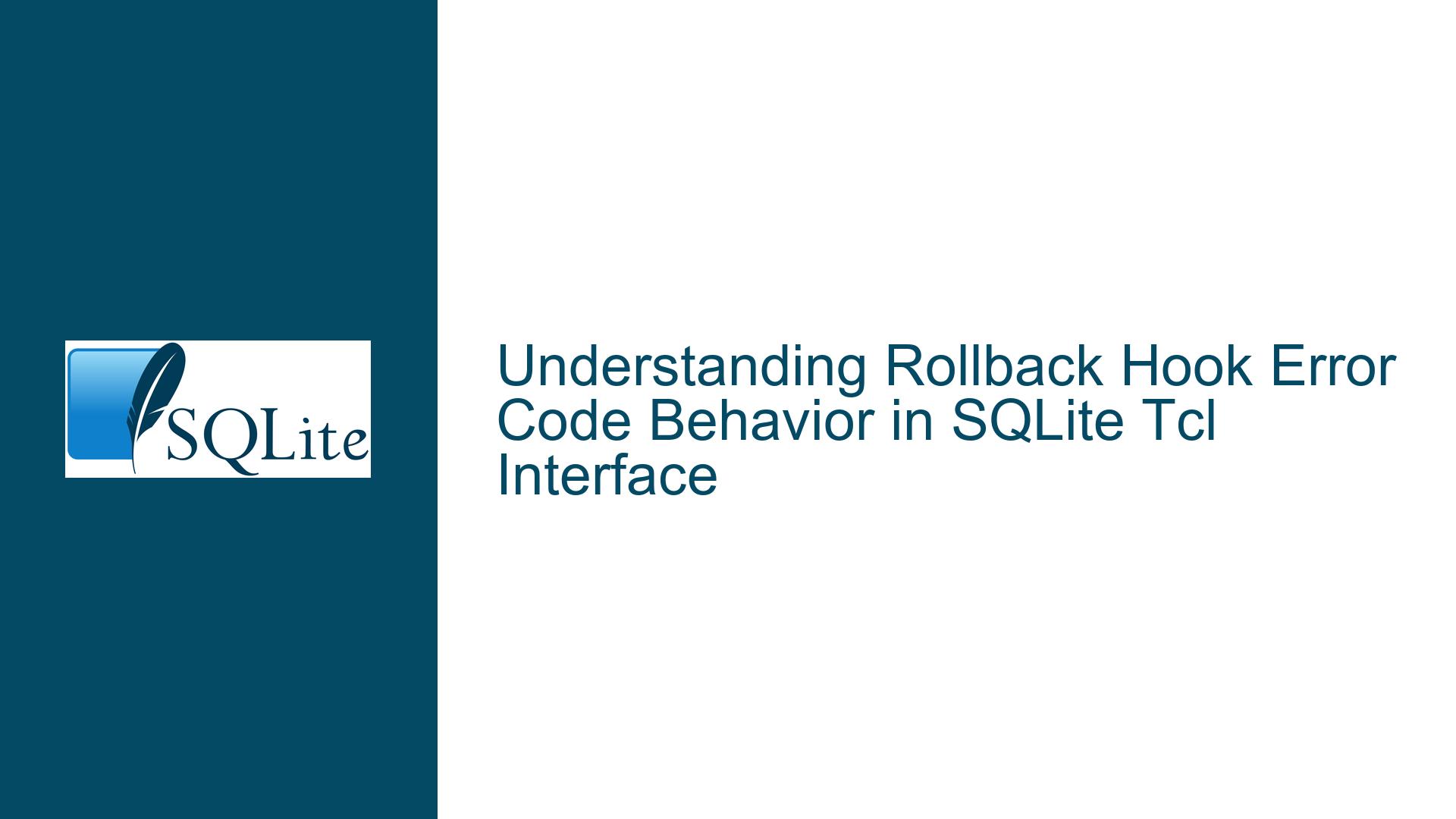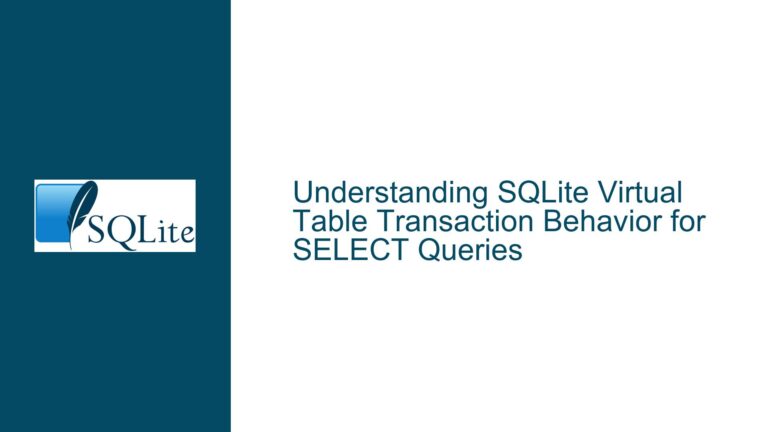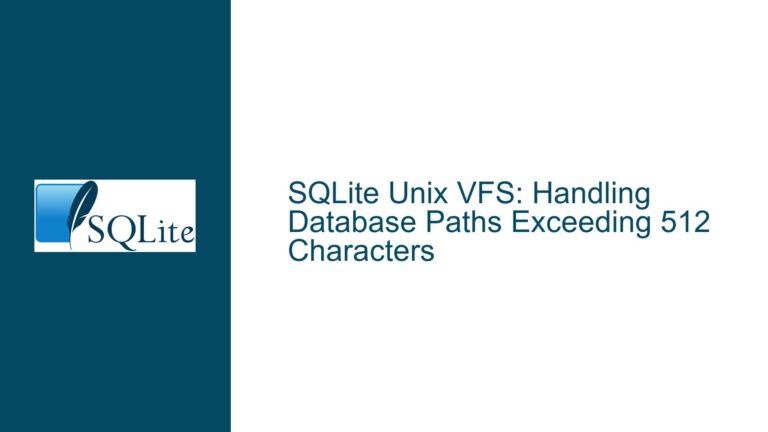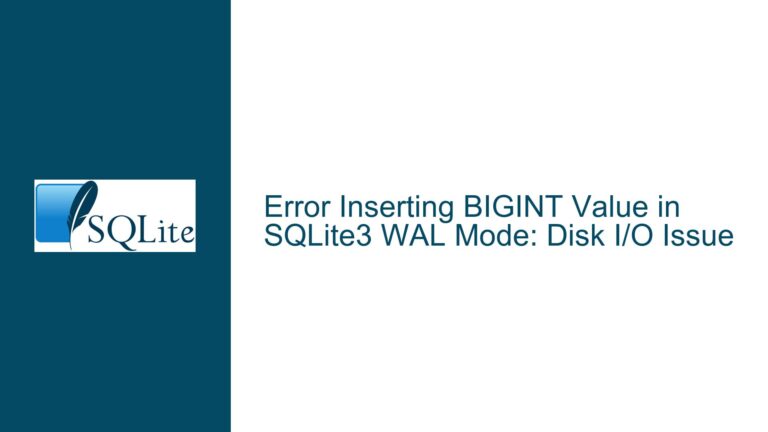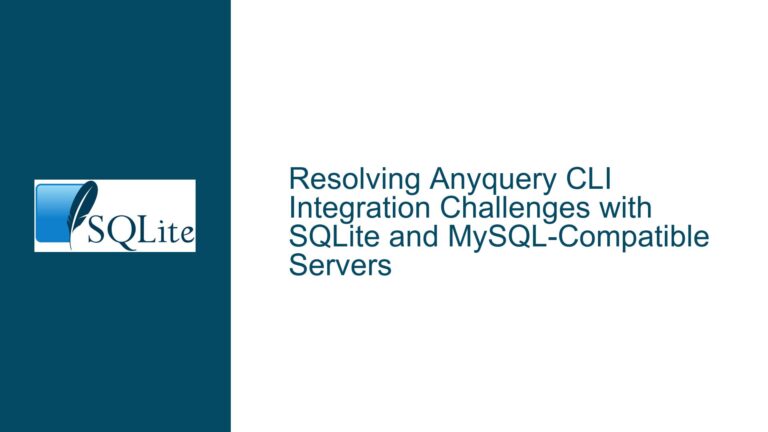Rollback Hook Error Code Behavior in SQLite Tcl Interface
Issue Overview: Rollback Hook Callback Reports Incorrect SQLite Error Code
When utilizing the SQLite Tcl interface, developers may encounter unexpected behavior when attempting to retrieve the error code associated with a failed SQL operation within a rollback_hook callback. The core issue manifests in scenarios where the errorcode method of the SQLite database handle returns 0 (SQLITE_OK) instead of the expected error code (e.g., 19 for constraint violations) during rollback processing. This discrepancy arises under specific transactional workflows, particularly when comparing manual transaction management (using BEGIN/ROLLBACK) with the automated transaction method provided by the Tcl interface.
The problem is rooted in the interaction between SQLite’s error code lifecycle, the timing of rollback hook invocation, and the transactional abstraction layers implemented by the Tcl interface. Specifically, the rollback_hook callback is designed to execute before the rollback operation is finalized, yet the observed error code within the hook may not reflect the error that triggered the rollback. This behavior is inconsistent across different transaction management strategies, leading to confusion about error handling guarantees.
Possible Causes: Error Code Reset Timing and Transaction Abstraction Layers
Transaction Method Internals (SAVEPOINT Usage):
Thetransactionmethod in the Tcl interface uses SQLite’sSAVEPOINTmechanism to implement nested transactions. When a transaction is rolled back via this method, the error code from the failing SQL operation may be cleared during the internal savepoint release or rollback process. This results in theerrorcodemethod returning0by the time therollback_hookis invoked.Error Code Reset After Statement Execution:
SQLite’serrorcodereflects the result of the most recent operation. If a rollback operation (explicit or implicit) is executed after a failed statement, theerrorcodemay be overwritten by the result of theROLLBACKcommand itself (0for success) before or during the hook’s execution.Hook Execution Context and Tcl Interface Behavior:
The Tcl interface’s implementation ofrollback_hookmay execute the callback in a context where the database handle’s internal state has already transitioned to post-rollback cleanup. This could reset the error code prematurely, especially if the rollback was triggered implicitly by an unhandled error in atransactionblock.Interleaving of Error Handling and Transaction Control:
Manual transaction management (e.g., explicitBEGIN/ROLLBACK) may leave the error code set to the value of the last failing operation until explicitly cleared. However, repeated rollbacks or overlapping transactions might inadvertently reset the error code due to edge cases in error state propagation.
Troubleshooting Steps, Solutions & Fixes: Capturing Reliable Error Codes During Rollbacks
Step 1: Validate Error Code Lifecycle with Manual Transactions
Begin by isolating the error code behavior in a controlled manual transaction workflow. Execute a failing SQL operation, capture the error code immediately after the failure, and compare it to the value reported within the rollback_hook:
db1 rollback_hook {
puts "Hook Error Code: [db1 errorcode]"
}
catch {
db1 eval {BEGIN}
db1 eval {UPDATE t1 SET a = NULL} ;# Fails with errorcode 19
}
set postUpdateError [db1 errorcode]
puts "Post-Update Error Code: $postUpdateError"
db1 eval {ROLLBACK}
Expected Outcome:
postUpdateErrorshould be19(constraint violation).- The
rollback_hookshould also report19, as the hook is invoked before theROLLBACKoperation, which would reset the error code to0.
If Discrepancy Observed:
This indicates that the Tcl interface or SQLite library is resetting the error code earlier than expected. Proceed to Step 2.
Step 2: Audit Transaction Method Internals
When using the transaction method, the Tcl interface wraps the transaction within a SAVEPOINT. This abstraction can alter error handling:
catch {
db1 transaction {
db1 eval {UPDATE t1 SET a = NULL}
}
}
set postTransError [db1 errorcode]
puts "Post-Transaction Error Code: $postTransError"
Expected Outcome:
- The
rollback_hookmay report0instead of19due to the savepoint rollback clearing the error code before invoking the hook. postTransErrorwill also be0because the transaction method catches and suppresses the error.
Solution:
Avoid relying on the errorcode method within rollback_hook when using automated transaction methods. Instead, capture the error code immediately after the failing operation inside the transaction block and propagate it to the hook via a variable:
set capturedError 0
db1 rollback_hook {
puts "Captured Error: $capturedError"
}
catch {
db1 transaction {
if {[catch {db1 eval {UPDATE t1 SET a = NULL}} err]} {
set ::capturedError [db1 errorcode]
error $err
}
}
}
Step 3: Handle Implicit vs. Explicit Rollbacks
Implicit rollbacks (e.g., due to unhandled errors in auto-commit mode) may reset the error code differently than explicit ROLLBACK commands. To diagnose:
# Force an implicit rollback via constraint violation without explicit transaction
catch {
db1 eval {UPDATE t1 SET a = NULL}
}
puts "Post-Implicit Rollback Error Code: [db1 errorcode]"
Expected Outcome:
The error code remains 19 if no explicit transaction was active. If the code is 0, SQLite’s auto-commit rollback behavior is clearing the error.
Solution:
Use explicit transactions to maintain control over error code states. Avoid relying on auto-commit mode when precise error code tracking is required.
Step 4: Ensure Hook Execution Order
Verify that the rollback_hook is invoked before the error code is reset by instrumenting the hook to log the error code and the current transaction state:
db1 rollback_hook {
puts "Hook Error Code: [db1 errorcode]"
puts "In Transaction: [db1 eval {SELECT * FROM sqlite_master WHERE type='transaction'}]"
}
catch {
db1 eval {BEGIN}
db1 eval {UPDATE t1 SET a = NULL}
db1 eval {COMMIT}
}
Analysis:
If the transaction is already inactive within the hook, the error code reset is occurring before hook execution. This suggests a deeper integration issue between the Tcl interface and SQLite’s rollback mechanics.
Step 5: Patch or Workaround for Transaction Method
If the transaction method’s error suppression is unavoidable, bypass it by implementing custom transaction logic with explicit SAVEPOINT commands:
proc safeTransaction {db script} {
set savepoint "sp_[clock seconds]"
$db eval "SAVEPOINT $savepoint"
if {[catch {uplevel 1 $script} result]} {
$db eval "ROLLBACK TO $savepoint"
$db eval "RELEASE $savepoint"
return -code error $result
} else {
$db eval "RELEASE $savepoint"
return $result
}
}
catch {
safeTransaction db1 {
db1 eval {UPDATE t1 SET a = NULL}
}
}
puts "Post-Custom Transaction Error Code: [db1 errorcode]"
Outcome:
This custom transaction handler preserves the error code from the failing operation, allowing the rollback_hook to access it reliably.
Final Recommendations
Prefer Manual Error Code Capture:
Immediately after a failing SQL operation, store the error code in a variable before triggering a rollback. Reference this variable within therollback_hookinstead of queryingerrorcodedynamically.Avoid Transaction Method for Critical Error Handling:
Use explicitBEGIN/COMMIT/ROLLBACKblocks when precise error code tracking is necessary, as thetransactionmethod’s abstraction layer may obscure error states.Monitor SQLite and Tcl Interface Updates:
Review changelogs for fixes related to error code management in transactional contexts. Test edge cases after upgrades to confirm behavior consistency.
By systematically isolating transactional workflows and understanding the interplay between SQLite’s error lifecycle and Tcl’s interface abstractions, developers can implement robust error handling strategies that circumvent the limitations observed in rollback_hook error code reporting.
